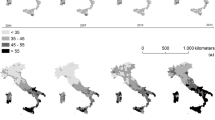Abstract
The core of this study is the development of a statistical tool for measuring the regional labour market sensitivity. The goal is to present and apply a general index, which can be used in other disciplines as well. An additional objective is the evaluation of the social and economic processes affecting the labour market, and the identification of highly vulnerable areas exposed to crises. In this study, sensitivity means the relative volume of responsiveness to the labour market changes in the examined areas. Former spatial statistical methods have tried to identify the regional differentiating factors of unemployment; however, they did not reveal the extent to which the villages and towns were exposed to economic and employment changes. A new index provides this opportunity. It evaluates the processes of regional unemployment, the degree of exposure to the crisis and the employment mechanisms with particular regard to public employment programmes. The research explores and evaluates the specific labour market vulnerability and macro-regional structure of the settlements of Hungary with the help of the developed index. Thus at least three new elements of the national spatial structure will be revealed which enables us to prepare for socio-economic changes similar to the latest crisis.





Similar content being viewed by others
References
Abraham, A., & Kertesi, G. (1996). A munkanélküliség regionális egyenlőtlenségei [The regional disparities of unemployment]. Economic Review, 43(7–8), 653–681.
Bodi, F., & Obadovics, C. S. (2000). Munkanélküliség a vidéki Magyarországon [Unemployment in rural Hungary]. Regional Statistics, 40(1), 55–68.
Boeri, T., Jimeno, J.F. (2015). Unemployment in Europe: what does it take to bring it down? Paper prepared for the ECB forum on central banking, Sintra, 21–23 May 2015, 36 p.
Dusek, T., Lukacs, R., & Racz, I. (2014). Development differences among the regions of Hungary. Procedia Economics and Finance, 9(2014), 264–277.
Enyedi, G. Y. (2009). Competitiveness of the Hungarian regions. Hungarian Geographical Bulletin, 58(1), 33–48.
Fazekas, K. (2000). The impact of foreign direct investment inflows on regional labour markets in Hungary. Budapest Working Papers on the Labour Market, 8(2000).
Gardiner, B., Martin, R., & Tyler, P. (2004). Competitiveness, productivity and economic growth across the European regions. Regional Studies, 38(1), 1045–1067.
Hanappi, H. (2015). Unemployment in Mediterranean EU countries. Fighting youth unemployment. In S. Katsikides & P. I. Koktsidis (Eds.), Societies in transition. The social implications of economic, political and security transformations (pp. 39–55). Switzerland: Springer International Publishing.
Harcsa, I. (2011). Gondolatok a társadalmi fejlődés méréséről [Thoughts on the measurement of social progress]. Statistical Review, 89(10–11), 1081–1097.
Jackson, T. (2009). Prosperity without growth? – The transition to a sustainable economy sustainable development commission. London.
Obadovics, C. S. (1997). A népsűrűség és a nagyváros-közeliség hatása a munkanélküliségre falun. [Effect of the population density and large-city proximity on unemployment in villages]. In T. Kovacs (Ed.) A fenntartható mezőgazdaságtól a vidékfejlesztésig. [From sustainable agriculture to rural development] (pp. 445–451). Village Conference IV, MTA RKK Pécs.
OECD/DAC. (2008a). Service delivery in fragile states: key concepts, findings and lessons. OECD/DAC Discussion Paper, Paris. http://www.oecd.org/development/incaf/40886707.pdf. (downloaded June 2014).
OECD/DAC. (2008b). Concepts and dilemmas of state building in fragile situations. From fragility to resilience. OECD/DAC Discussion Paper, Paris. http://www.oecd.org/development/incaf/41100930.pdf. (downloaded June 2014).
Praussello, F. (2015). The impact of the Eurozone crisis on a periphery country: The case of Italy. In S. Katsikides & P. I. Koktsidis (Eds.), Societies in transition. The social implications of economic, political and security transformations (pp. 57–86). Switzerland: Springer International Publishing.
Stiglitz, J., Sen, A., & Fitoussi, J. P. (2010). Report by the Commission on the Measurement of Economic Performance and Social Progress. http://www.insee.fr/fr/publications-et-services/dossiers_web/stiglitz/doc-commission/RAPPORT_anglais.pdf. (downloaded June 2014).
Szekely-Doby, A. (2007). Foreign investments and economic catching up: the case of Hungary. Economic research. Economic Research Institute at the Bulgarian Academy of Sciences, 1(1), 55–65.
Tury, G. (2002a). Sector and industry structure of the Hungarian economy in international comparison. In R. Outrata & M. Gajdosova (Eds.), Effects and perspectives of cooperation of Visegrad countries and of their EU integration (pp. 121–143). Bratislava: Institute of Slovak and World Economy.
Tury, G. (2002b). Change of regional inequalities in the Visegrad countries in the last years. In: Vordem EU Beitritt Tendenzen und Perspektiven des Struktur wandels und der Migration in Zentraleuropa, Dresden: IFO Institut (pp. 45–55).
Author information
Authors and Affiliations
Corresponding author
Rights and permissions
About this article
Cite this article
Alpek, L., Tésits, R. Measuring Regional Differences in Labour Market Sensitivity in Hungary. Appl. Spatial Analysis 12, 127–146 (2019). https://doi.org/10.1007/s12061-017-9237-3
Received:
Accepted:
Published:
Issue Date:
DOI: https://doi.org/10.1007/s12061-017-9237-3




